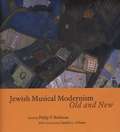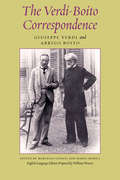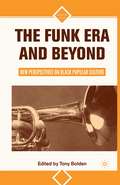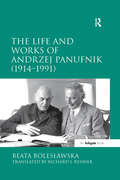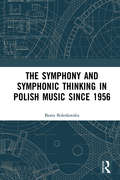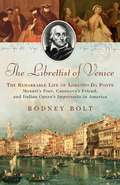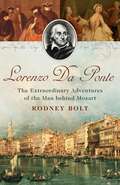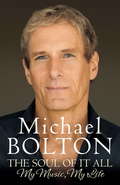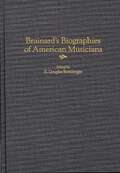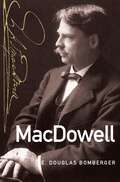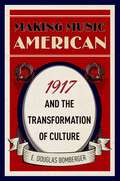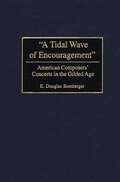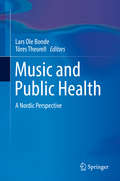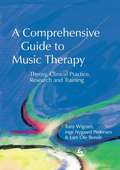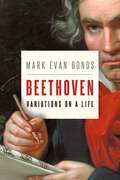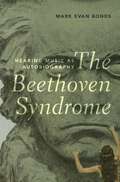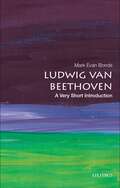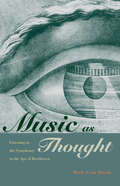- Table View
- List View
Jewish Musical Modernism, Old and New
by Philip Vilas Bohlman Sander L. GilmanTackling the myriad issues raised by Sander Gilman’s provocative opening salvo—”Are Jews Musical?”—this volume’s distinguished contributors present a series of essays that trace the intersections of Jewish history and music from the late nineteenth century to the present. Covering the sacred and the secular, the European and the non-European, and all the arenas where these realms converge, these essays recast the established history of Jewish culture and its influences on modernity. Mitchell Ash explores the relationship of Jewish scientists to modernist artists and musicians, while Edwin Seroussi looks at the creation of Jewish sacred music in nineteenth-century Vienna. Discussing Jewish musicologists in Austria and Germany, Pamela Potter details their contributions to the “science of music” as a modern phenomenon. Kay Kaufman Shelemay investigates European influence in the music of an Ethiopian Jewish community, and Michael P. Steinberg traces the life and works of Charlotte Salomon, whose paintings staged the destruction of the Holocaust. Bolstered by Philip V. Bohlman’s wide-ranging introduction and epilogue, and featuring lush color illustrations and a complementary CD of the period’s music, this volume is a lavish tribute to Jewish contributions to modernity.
The Verdi-Boito Correspondence
by Arrigo Boito Giuseppe VerdiThese 301 letters between Giuseppe Verdi and his last, most gifted librettist, Arrigo Boito, document an extraordinary chapter in musical history. Now available for the first time in English, this correspondence records both a unique friendship and its creative legacy. This new edition of the landmark Carteggio Verdi/Boito is at once a valuable resource for all students, teachers, and scholars of opera and a fascinating glimpse of the daily life of European art and artists during the fertile last decades of the 19th century. Embarking on a 20-year collaboration, Verdi and Boito produced a successful revision of Simon Boccanegra, and two new operas, Otello and Falstaff. They created what many consider to be Verdi's greatest operas, thanks both to Boito's poetry and to his handling of the composer. Here are the day-to-day tasks of creation: poet and composer debating problems of dramatic structure, words, phrases, and meters; altering dialogue as, at the same time, they converse about the wider worlds of art and music. The give and take of artistic creation is rendered fascinatingly. This edition features a new introduction by Marcello Conati, improvements and updatings to the original edition, and an appendix of undated correspondence. William Weaver's translation is characteristically pitch-perfect; he also provides a short closing sketch of Boito's life after the death of his beloved maestro. Explanatory "linking texts" between the letters create a narrative.
The Funk Era and Beyond: New Perspectives on Black Popular Culture (Signs of Race)
by T. BoldenThe Funk Era and Beyond is the first scholarly collection to discuss the significance of funk music in America. Contributors employ a multitude of methodologies to examine this unique musical genre's relationship to African American culture and to music, literature, and visual art as a whole.
The Life and Works of Andrzej Panufnik (1914-1991)
by Beata Boles?awskaSir Andrzej Panufnik was born in Warsaw and studied in the newly independent Poland in the 1930s, as well as in Vienna and Paris just before the outbreak of the Second World War. During the German occupation he formed a piano duo with his friend and fellow composer Witold Lutoslawski, and they performed in caf around Warsaw. After the war, Panufnik quickly established himself as a leading Polish composer, and as a conductor he played a significant role in the re-establishment of first the Krak nd then the Warsaw Philharmonic. Although he was considered Polands leading composer for some years after the war, Panufnik was subsequently put under intolerable pressure both musically and politically. Frustrated by the continuing rejection of his compositions and the unending political demands inflicted on him by the country‘s post-war Communist regime, he made a daring escape to England in 1954. He briefly became Principal Conductor of the City of Birmingham Symphony Orchestra, a post he relinquished after two years to devote all his time to composition. His works were in demand by major figures such as Leopold Stokowski who conducted the first performances of Sinfonia Elegiaca, Katyn Epitaph and Universal Prayer, Yehudi Menuhin who commissioned the Violin Concerto, Seiji Ozawa in Boston and Sir Georg Solti in Chicago who both commissioned symphonies for the centenaries of their famous orchestras; also Mstislav Rostropovich with the London Symphony Orchestra, who together commissioned the Cello Concerto. Beata Boleslawska has written the first book on the life and artistic output of Panufnik, setting his significance alongside the political and cultural scene of twentieth-century Europe. The account of the composer‘s life is based on numerous archival documents, as well as the personal accounts contributed by his family and friends. Panufnik‘s compositional style and techniques are also analysed. This book will be of interest not only to those devoted
The Life and Works of Andrzej Panufnik (1914-1991)
by Beata Boles?awskaSir Andrzej Panufnik was born in Warsaw and studied in the newly independent Poland in the 1930s, as well as in Vienna and Paris just before the outbreak of the Second World War. During the German occupation he formed a piano duo with his friend and fellow composer Witold Lutoslawski, and they performed in caf around Warsaw. After the war, Panufnik quickly established himself as a leading Polish composer, and as a conductor he played a significant role in the re-establishment of first the Krak nd then the Warsaw Philharmonic. Although he was considered Polands leading composer for some years after the war, Panufnik was subsequently put under intolerable pressure both musically and politically. Frustrated by the continuing rejection of his compositions and the unending political demands inflicted on him by the country‘s post-war Communist regime, he made a daring escape to England in 1954. He briefly became Principal Conductor of the City of Birmingham Symphony Orchestra, a post he relinquished after two years to devote all his time to composition. His works were in demand by major figures such as Leopold Stokowski who conducted the first performances of Sinfonia Elegiaca, Katyn Epitaph and Universal Prayer, Yehudi Menuhin who commissioned the Violin Concerto, Seiji Ozawa in Boston and Sir Georg Solti in Chicago who both commissioned symphonies for the centenaries of their famous orchestras; also Mstislav Rostropovich with the London Symphony Orchestra, who together commissioned the Cello Concerto. Beata Boleslawska has written the first book on the life and artistic output of Panufnik, setting his significance alongside the political and cultural scene of twentieth-century Europe. The account of the composer‘s life is based on numerous archival documents, as well as the personal accounts contributed by his family and friends. Panufnik‘s compositional style and techniques are also analysed. This book will be of interest not only to those devoted
The Symphony and Symphonic Thinking in Polish Music Since 1956
by Beata Bolesławska1956 was a year of transition in Poland, and an important year for Polish music. This year saw the beginning of a political thaw – sometimes called the Polish October – in communist Poland. It was also the year of the establishment of the 'Warsaw Autumn' International Festival of Contemporary Music. This was a time of great artistic ferment in Polish music, which also deeply influenced symphonic thinking. The year 1956 is thus an appropriate starting point for Beata Bolesławska’s study of the contemporary Polish symphonic tradition. Bolesławska investigates the influential Polish avant-garde, illuminating the ways in which new musical means and ideas influenced symphonic music and the genre of the symphony in the music of such important composers as Witold Lutosławski (1913–1994), Henryk Mikołaj Górecki (1933–2010) and Krzysztof Penderecki (b. 1933). Referring to the main elements of the European tradition, as well as examining briefly the symphonic activity in Poland before 1956, the book concentrates on the symphonic writing in the context of avant-garde trends, represented by the so-called 'Polish school of composers', as well as on its later redefinitions proposed by Polish composers up to the present day.
The Symphony and Symphonic Thinking in Polish Music Since 1956
by Beata Bolesławska1956 was a year of transition in Poland, and an important year for Polish music. This year saw the beginning of a political thaw – sometimes called the Polish October – in communist Poland. It was also the year of the establishment of the 'Warsaw Autumn' International Festival of Contemporary Music. This was a time of great artistic ferment in Polish music, which also deeply influenced symphonic thinking. The year 1956 is thus an appropriate starting point for Beata Bolesławska’s study of the contemporary Polish symphonic tradition. Bolesławska investigates the influential Polish avant-garde, illuminating the ways in which new musical means and ideas influenced symphonic music and the genre of the symphony in the music of such important composers as Witold Lutosławski (1913–1994), Henryk Mikołaj Górecki (1933–2010) and Krzysztof Penderecki (b. 1933). Referring to the main elements of the European tradition, as well as examining briefly the symphonic activity in Poland before 1956, the book concentrates on the symphonic writing in the context of avant-garde trends, represented by the so-called 'Polish school of composers', as well as on its later redefinitions proposed by Polish composers up to the present day.
The Librettist of Venice: The Remarkable Life of Lorenzo Da Ponte--Mozart's Poet, Casanova's Friend, and Italian Opera's Impre
by Rodney BoltIn 1805, Lorenzo Da Ponte was the proprietor of a small grocery store in New York. But since his birth into an Italian Jewish family in 1749, he had already been a priest, a poet, the lover of many women, a scandalous Enlightenment thinker banned from teaching in Venice, the librettist for three of Mozart's most sublime operas, a collaborator with Salieri, a friend of Casanova, and a favorite of Emperor Joseph II. He would go on to establish New York City's first opera house and be the first professor of Italian at Columbia University. An inspired innovator but a hopeless businessman, who loved with wholehearted loyalty and recklessness, Da Ponte was one of the early immigrants to live out the American dream. In Rodney Bolt's rollicking and extensively researched biography, Da Ponte's picaresque life takes readers from Old World courts and the back streets of Venice, Vienna, and London to the New World promise of New York City. Two hundred and fifty years after Mozart's birth, the life and legacy of his librettist Da Ponte are as astonishing as ever.
Lorenzo da Ponte: The Extraordinary Adventures of the Man Behind Mozart
by Rodney BoltBy the time he was forty, Lorenzo Da Ponte had been a poet, priest, lover and libertine, a friend of Casanova, collaborator then enemy of Salieri, and ultimately the librettist for three of Mozart's most sublime operas - The Marriage of Figaro, Così fan tutte and Don Giovanni. After losing all his money and the woman he loved he started afresh in New York, and by the end of his life he had founded its first opera house and become a university professor. Lorenzo Da Ponte is a fascinating and entertaining biography of a larger-than-life character, and a vibrant portrait of four cities and four changing eras of history.
The Soul of It All: My Music, My Life
by Michael BoltonAfter four decades in the music industry, Michael Bolton has cemented himself as one of the most successful musicians of our time. THE SOUL OF IT ALL is his backstage pass into his life lived thus far - into the venues, buses, limos and hotel rooms of stardom, and finally into his home and heart. His story will go long and dive deep, not only into his self-proclaimed 'vagabond vampire' life, but also into the belly of the beast that is the music industry, with its joys, follies and torments.From a 14-year-old kid performing in dive bars to struggling to provide for his wife and kids, to finally breaking through with the Soul Provider album, Bolton has fought for and earned a life most just dream of. THE SOUL OF IT ALL is his life, chockful of all the incredible stories, and the star-studded cast you'd expect, including: Pavarotti, Bob Dylan, Barbra Streisand, Celine Dion, Ray Charles and Lady Gaga.
Brainard's Biographies of American Musicians (Music Reference Collection)
by E. Douglas BombergerThe series of biographical sketches published by Brainard's Musical World between 1877 and 1889 is notable for the diversity of the musicians profiled and for the entertaining personal information provided. This period witnessed the establishment of musical institutions and attitudes toward music that have shaped American music to the present day. The biographies present a cross-section of American musicians in the late 19th century, including singers, instrumentalists, writers, teachers, and composers. Among the musicians included are some of America's most prominent conductors, such as Theodore Thomas and Leopold Damrosch; composers, such as John Knowles Paine and George F. Root; writers, such as John S. Dwight and Amy Fay; teachers, such as William Mason and Erminia Rudersdorff; and performers, such as Emma Abbott and Maud Powell. Scores of less familiar musicians who were also instrumental in shaping America's music are included as well. Originally intended for general readers, the biographical sketches not only shed light on musical topics but also include personal information that is seldom found in a traditional dictionary and which speaks to the attitudes and concerns of the late 19th century society.This work will be of value to scholars and researchers of 19th-century American music and to those interested in the development of popular song. Entries are alphabetically arranged and include select bibliographies. A general bibliography and index are also included.
MacDowell: Essays On Edward Macdowell (Master Musicians Series #5)
by E. Douglas BombergerEdward MacDowell was born on the eve of the Civil War into a Quaker family in lower Manhattan, where music was a forbidden pleasure. With the help of Latin-American émigré teachers, he became a formidable pianist and composer, spending twelve years in France and Germany establishing his career. Upon his return to the United States in 1888 he conquered American audiences with his dramatic Second Piano Concerto and won his way into their hearts with his poetic Woodland Sketches. Columbia University tapped him as their first professor of music in 1896, but a scandalous row with powerful university president Nicholas Murray Butler spelled the end of his career. MacDowell died a broken man four years later, but his widow Marian kept his spirit alive through the MacDowell Colony, which she founded in 1907 in their New Hampshire home, and which is today the oldest and one of the most influential, thriving artist colonies in the the United States. Drawing on private letters that were sealed for fifty years after his death, this biography traces MacDowell's compelling life story, with new revelations about his Quaker childhood, his efforts to succeed in the insular German music world, his mysterious death, and his lifelong struggle with Seasonal Affective Disorder. Edward MacDowell's story is a timeless tale of human strength and weakness set in one of the most vibrant periods of American musical history, when optimism about the country's artistic future made anything seem possible.
MacDowell (Master Musicians Series)
by E. Douglas BombergerEdward MacDowell was born on the eve of the Civil War into a Quaker family in lower Manhattan, where music was a forbidden pleasure. With the help of Latin-American émigré teachers, he became a formidable pianist and composer, spending twelve years in France and Germany establishing his career. Upon his return to the United States in 1888 he conquered American audiences with his dramatic Second Piano Concerto and won his way into their hearts with his poetic Woodland Sketches. Columbia University tapped him as their first professor of music in 1896, but a scandalous row with powerful university president Nicholas Murray Butler spelled the end of his career. MacDowell died a broken man four years later, but his widow Marian kept his spirit alive through the MacDowell Colony, which she founded in 1907 in their New Hampshire home, and which is today the oldest and one of the most influential, thriving artist colonies in the the United States. Drawing on private letters that were sealed for fifty years after his death, this biography traces MacDowell's compelling life story, with new revelations about his Quaker childhood, his efforts to succeed in the insular German music world, his mysterious death, and his lifelong struggle with Seasonal Affective Disorder. Edward MacDowell's story is a timeless tale of human strength and weakness set in one of the most vibrant periods of American musical history, when optimism about the country's artistic future made anything seem possible.
Making Music American: 1917 and the Transformation of Culture
by E. Douglas BombergerThe year 1917 was unlike any other in American history, or in the history of American music. The United States entered World War I, jazz burst onto the national scene, and the German musicians who dominated classical music were forced from the stage. As the year progressed, New Orleans natives Nick LaRocca and Freddie Keppard popularized the new genre of jazz, a style that suited the frantic mood of the era. African-American bandleader James Reese Europe accepted the challenge of making the band of the Fifteenth New York Infantry into the best military band in the country. Orchestral conductors Walter Damrosch and Karl Muck met the public demand for classical music while also responding to new calls for patriotic music. Violinist Fritz Kreisler, pianist Olga Samaroff, and contralto Ernestine Schumann-Heink gave American audiences the best of Old-World musical traditions while walking a tightrope of suspicion because of their German sympathies. Before the end of the year, the careers of these eight musicians would be upended, and music in America would never be the same. Making Music American recounts the musical events of this tumultuous year month by month from New Year's Eve 1916 to New Year's Day 1918. As the story unfolds, the lives of these eight musicians intersect in surprising ways, illuminating the transformation of American attitudes toward music both European and American. In this unsettled time, no one was safe from suspicion, but America's passion for music made the rewards high for those who could balance musical skill with diplomatic savvy.
Making Music American: 1917 and the Transformation of Culture
by E. Douglas BombergerThe year 1917 was unlike any other in American history, or in the history of American music. The United States entered World War I, jazz burst onto the national scene, and the German musicians who dominated classical music were forced from the stage. As the year progressed, New Orleans natives Nick LaRocca and Freddie Keppard popularized the new genre of jazz, a style that suited the frantic mood of the era. African-American bandleader James Reese Europe accepted the challenge of making the band of the Fifteenth New York Infantry into the best military band in the country. Orchestral conductors Walter Damrosch and Karl Muck met the public demand for classical music while also responding to new calls for patriotic music. Violinist Fritz Kreisler, pianist Olga Samaroff, and contralto Ernestine Schumann-Heink gave American audiences the best of Old-World musical traditions while walking a tightrope of suspicion because of their German sympathies. Before the end of the year, the careers of these eight musicians would be upended, and music in America would never be the same. Making Music American recounts the musical events of this tumultuous year month by month from New Year's Eve 1916 to New Year's Day 1918. As the story unfolds, the lives of these eight musicians intersect in surprising ways, illuminating the transformation of American attitudes toward music both European and American. In this unsettled time, no one was safe from suspicion, but America's passion for music made the rewards high for those who could balance musical skill with diplomatic savvy.
A Tidal Wave of Encouragement: American Composers' Concerts in the Gilded Age (Non-ser.)
by E. Douglas BombergerIn July of 1884, pianist Calixa Lavallée performed a recital of works by American composers that began a highly influential series of such concerts. Over the course of the next decade, hundreds of all-American concerts were performed in the United States and Europe, a movement that fostered both the development and the perception of American music as a unique art form. A Tidal Wave of Encouragement-the title of which is derived from one observer's description of the movement-is the first in-depth study of this significant period in American music. Providing a comprehensive history of the Concerts as well as detailed accounts of the intense critical debate surrounding them, author E. Douglas Bomberger reveals how one decade shaped the future of American classical music and very much impacted the way we hear it today.The movement, crucial in focusing discussion on American music and providing performance opportunities for composers and musicians for whom no such opportunities had before existed, was far more extensive and widespread than most scholarship had credited it. This oversight is due in large part to the dearth of objective studies of the Concerts; previous considerations have tended either toward the merely nostalgic or toward the unnecessarily disparaging. Bomberger's work is a corrective to this, as well as much-needed historical and critical account of a project whose influence had yet to be fully acknowledged.
Music and Public Health: A Nordic Perspective
by Lars Ole Bonde Töres TheorellFrom the Nordic countries (Denmark, Norway, Sweden and Finland) comes an exciting source of theoretical approaches, epidemiological findings, and real-life examples regarding the therapeutic and health-enhancing effects of music. Experts across fields including psychology, neurology, music therapy, medicine, and public health review research on the benefits of music in relieving physiological, psychological, and socioemotional dysfunction. Chapters link musical experiences (listening and performing, as well as involvement in movement, dance, and theatre) to a wide range of clinical and non-clinical objectives such as preventing isolation, regulating mood, reducing stress and its symptoms, and treating dementia. And the book’s section on innovative music-based interventions illustrates opportunities for incorporating musical activities into public health programs. Among the topics covered are: · Associations between the use of music, cultural participation and health-related outcomes in adult Scandinavian populations · Music practice and emotion handling · How music translates itself biologically in the body · Music as a forum for social-emotional health · Participation and partnership as core concepts in music and public health · Music therapy as health promotion for mothers and children at a public health clinic Music and Public Health will gain interested readers among researchers, teachers, students, and clinicians in the fields of music education and therapy, as well as researchers and students of public health who are interested in the influence of culture and the arts. The book also will be relevant to administrators in public health services.
A Comprehensive Guide to Music Therapy: Theory, Clinical Practice, Research and Training (PDF)
by Lars Ole Bonde Tony WigramMusic therapists, as in medical and paramedical professions, have a rich diversity of approaches and methods, often developed with specific relevance to meet the needs of a certain client population. This book reflects the many components of such diversity, and is a thoroughly comprehensive guide to accessing and understanding the ideas, theory, research results and clinical outcomes that are the foundations of this field. Providing a detailed insight into the field of music therapy from an international perspective, this book enables the reader to see the complete picture of the multifaceted and fascinating world that is music therapy.
Beethoven: The Imperative Of Originality In The Symphony (Eastman Studies In Music Ser. #172)
by Mark Evan BondsDespite the ups and downs of his personal life and professional career-even in the face of deafness-Beethoven remained remarkably consistent in his most basic convictions about his art. This inner consistency, the music historian Mark Evan Bonds argues, provides the key to understanding the composer's life and works. Beethoven approached music as he approached life, weighing whatever occupied him from a variety of perspectives: a melodic idea, a musical genre, a word or phrase, a friend, a lover, a patron, money, politics, religion. His ability to unlock so many possibilities from each helps explain the emotional breadth and richness of his output as a whole, from the heaven-storming Ninth Symphony to the eccentric Eighth, and from the arcane Great Fugue to the crowd-pleasing Wellington's Victory. Beethoven's works, Bonds argues, are a series of variations on his life. The iconic scowl so familiar from later images of the composer is but one of many attitudes he could assume and project through his music. The supposedly characteristic furrowed brow and frown, moreover, came only after his time. Discarding tired myths about the composer, Bonds proposes a new way of listening to Beethoven by hearing his music as an expression of his entire self, not just his scowling self.
The Beethoven Syndrome: Hearing Music as Autobiography
by Mark Evan BondsThe "Beethoven Syndrome" is the inclination of listeners to hear music as the projection of a composer's inner self. This was a radically new way of listening that emerged only after Beethoven's death. Beethoven's music was a catalyst for this change, but only in retrospect, for it was not until after his death that listeners began to hear composers in general--and not just Beethoven--in their works, particularly in their instrumental music. The Beethoven Syndrome: Hearing Music as Autobiography traces the rise, fall, and persistence of this mode of listening from the middle of the eighteenth century to the present. Prior to 1830, composers and audiences alike operated within a framework of rhetoric in which the burden of intelligibility lay squarely on the composer, whose task it was to move listeners in a calculated way. But through a confluence of musical, philosophical, social, and economic changes, the paradigm of expressive objectivity gave way to one of subjectivity in the years around 1830. The framework of rhetoric thus yielded to a framework of hermeneutics: concert-goers no longer perceived composers as orators but as oracles to be deciphered. In the wake of World War I, however, the aesthetics of "New Objectivity" marked a return not only to certain stylistic features of eighteenth-century music but to the earlier concept of expression itself. Objectivity would go on to become the cornerstone of the high modernist aesthetic that dominated the century's middle decades. Masterfully citing a broad array of source material from composers, critics, theorists, and philosophers, Mark Evan Bonds's engaging study reveals how perceptions of subjective expression have endured, leading to the present era of mixed and often conflicting paradigms of listening.
The Beethoven Syndrome: Hearing Music as Autobiography
by Mark Evan BondsThe "Beethoven Syndrome" is the inclination of listeners to hear music as the projection of a composer's inner self. This was a radically new way of listening that emerged only after Beethoven's death. Beethoven's music was a catalyst for this change, but only in retrospect, for it was not until after his death that listeners began to hear composers in general--and not just Beethoven--in their works, particularly in their instrumental music. The Beethoven Syndrome: Hearing Music as Autobiography traces the rise, fall, and persistence of this mode of listening from the middle of the eighteenth century to the present. Prior to 1830, composers and audiences alike operated within a framework of rhetoric in which the burden of intelligibility lay squarely on the composer, whose task it was to move listeners in a calculated way. But through a confluence of musical, philosophical, social, and economic changes, the paradigm of expressive objectivity gave way to one of subjectivity in the years around 1830. The framework of rhetoric thus yielded to a framework of hermeneutics: concert-goers no longer perceived composers as orators but as oracles to be deciphered. In the wake of World War I, however, the aesthetics of "New Objectivity" marked a return not only to certain stylistic features of eighteenth-century music but to the earlier concept of expression itself. Objectivity would go on to become the cornerstone of the high modernist aesthetic that dominated the century's middle decades. Masterfully citing a broad array of source material from composers, critics, theorists, and philosophers, Mark Evan Bonds's engaging study reveals how perceptions of subjective expression have endured, leading to the present era of mixed and often conflicting paradigms of listening.
Beethoven: Variations on a Life
by Mark Evan BondsDespite the ups and downs of his personal life and professional career-even in the face of deafness-Beethoven remained remarkably consistent in his most basic convictions about his art. This inner consistency, the music historian Mark Evan Bonds argues, provides the key to understanding the composer's life and works. Beethoven approached music as he approached life, weighing whatever occupied him from a variety of perspectives: a melodic idea, a musical genre, a word or phrase, a friend, a lover, a patron, money, politics, religion. His ability to unlock so many possibilities from each helps explain the emotional breadth and richness of his output as a whole, from the heaven-storming Ninth Symphony to the eccentric Eighth, and from the arcane Great Fugue to the crowd-pleasing Wellington's Victory. Beethoven's works, Bonds argues, are a series of variations on his life. The iconic scowl so familiar from later images of the composer is but one of many attitudes he could assume and project through his music. The supposedly characteristic furrowed brow and frown, moreover, came only after his time. Discarding tired myths about the composer, Bonds proposes a new way of listening to Beethoven by hearing his music as an expression of his entire self, not just his scowling self.
Ludwig van Beethoven: A Very Short Introduction (Very Short Introductions)
by Mark Evan BondsProposes a new way of listening to Beethoven by understanding his music as an expression of his entire self, not just the iconic scowl Despite the ups and downs of his personal life and professional career - even in the face of deafness - Beethoven remained remarkably consistent in his most basic convictions about his art. This inner consistency, writes the music historian Mark Evan Bonds, provides the key to understanding the composer's life and works. Beethoven approached music as he approached life, weighing whatever occupied him from a variety of perspectives: a melodic idea, a musical genre, a word or phrase, a friend, a lover, a patron, money, politics, religion. His ability to unlock so many possibilities from each helps explain the emotional breadth and richness of his output as a whole, from the heaven-storming Ninth Symphony to the eccentric Eighth, and from the arcane Great Fugue to the crowd-pleasing Wellington's Victory. Beethoven's works, Bonds argues, are a series of variations on his life. The iconic scowl so familiar from later images of the composer is but one of many attitudes he could assume and project through his music. The supposedly characteristic furrowed brow and frown, moreover, came only after his time. Discarding tired myths about the composer, Bonds proposes a new way of listening to Beethoven by hearing his music as an expression of his entire self, not just his scowling self.
Ludwig van Beethoven: A Very Short Introduction (Very Short Introductions)
by Mark Evan BondsProposes a new way of listening to Beethoven by understanding his music as an expression of his entire self, not just the iconic scowl Despite the ups and downs of his personal life and professional career - even in the face of deafness - Beethoven remained remarkably consistent in his most basic convictions about his art. This inner consistency, writes the music historian Mark Evan Bonds, provides the key to understanding the composer's life and works. Beethoven approached music as he approached life, weighing whatever occupied him from a variety of perspectives: a melodic idea, a musical genre, a word or phrase, a friend, a lover, a patron, money, politics, religion. His ability to unlock so many possibilities from each helps explain the emotional breadth and richness of his output as a whole, from the heaven-storming Ninth Symphony to the eccentric Eighth, and from the arcane Great Fugue to the crowd-pleasing Wellington's Victory. Beethoven's works, Bonds argues, are a series of variations on his life. The iconic scowl so familiar from later images of the composer is but one of many attitudes he could assume and project through his music. The supposedly characteristic furrowed brow and frown, moreover, came only after his time. Discarding tired myths about the composer, Bonds proposes a new way of listening to Beethoven by hearing his music as an expression of his entire self, not just his scowling self.
Music as Thought: Listening to the Symphony in the Age of Beethoven
by Mark Evan BondsBefore the nineteenth century, instrumental music was considered inferior to vocal music. Kant described wordless music as "more pleasure than culture," and Rousseau dismissed it for its inability to convey concepts. But by the early 1800s, a dramatic shift was under way. Purely instrumental music was now being hailed as a means to knowledge and embraced precisely because of its independence from the limits of language. What had once been perceived as entertainment was heard increasingly as a vehicle of thought. Listening had become a way of knowing. Music as Thought traces the roots of this fundamental shift in attitudes toward listening in the late eighteenth and early nineteenth centuries. Focusing on responses to the symphony in the age of Beethoven, Mark Evan Bonds draws on contemporary accounts and a range of sources--philosophical, literary, political, and musical--to reveal how this music was experienced by those who heard it first. Music as Thought is a fascinating reinterpretation of the causes and effects of a revolution in listening.
